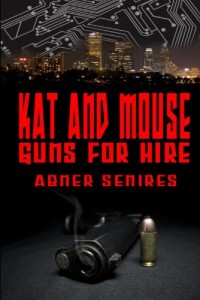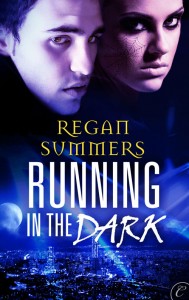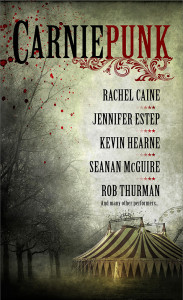As we continue our week of Author Interviews, I am absolutely thrilled to introduce you all to one of my personal favorites, Abner Senires. Abner writes some of the best hard-core cyberpunk tales out there and does so with a unique, serialized approach. In 2011, he published the first “season” of KAT AND MOUSE, much to the delight of his fans. I sat down (online) with Abner to get a closer look at the characters and how he decided on the “episode” format for his stories.
That said, please help me welcome: Abner Senires!
JR: Let’s start by talking about my two favorite girls: KAT AND MOUSE. What was your inspiration for them? How about reasons for their, shall we say “unique” taste in toys?
AS: The inspiration for the Duo came from three pairs women: Xena and Gabrielle from XENA: WARRIOR PRINCESS; Rally and Minnie May from GUNSMITH CATS; and Kei and Yuri from the DIRTY PAIR. I had been toying with the idea of writing a series of connected stories featuring recurring characters after reading a bunch of Conan short stories and novellas. Since I’m a big fan of the ass-kicking female warrior type, I thought, “Hey! Why not have two female leads? That would be cool!” Xena was already set in a mythic past. DIRTY PAIR was set in a distant future. And GUNSMITH CATS was set in the present-day. So then I thought: “Let’s set it in the near-future. Go cyberpunk.”
Boom. Enter: Kat and Mouse.
Now for their toys.
Kat’s pistols are modeled after the Springfield Armory Operator, which is based on the Colt 1911 pistol. I went with this because I happen to be a fan of those pistol styles and I felt Murphy, Kat’s mentor was an “old school” kind of guy. These would be the kind of sidearms he’d favor.
For Mouse I decided to go with bladed weapons. But instead of having her tote around a katana, I figured she’d go with something more compact. So I went with the short sword–the wakizashi. Granted it’s not the primary weapon one would use, but I thought it would work better when she fights dual-weapon style.
And on the subject of twin weapons–Kat’s twin guns. Yes, I know it’s kinda hokey and if you talk with most folks who use guns, it’s impractical. But I wanted to keep an element of John Woo gun-fu in the story so I went with that for Kat. And to address the issues around aiming with twin guns, I note early on (in the story “Easy Money”) that Kat is a natural crack shot whether right-handed or left-handed so it’s implied (I hope) that she’s able to target quickly when using both guns.
Also, she only fires straight on. I don’t do that Hollywood thing of guns pointed in two different directions and then hitting both targets at the same time. No. THAT’S impractical. If there are two opponents at angles from her, she’ll shoot one first, moving off-line, then pivot and get the other guy.
JR: KAT AND MOUSE is a rare treat for fans of Cyberpunk. What drew you to that genre? What can you tell us about the world that the girls live and operate in?
AS: The first thing that drew me to the genre was the look. I was already a fan of William Gibson and the visuals of BLADE RUNNER and ROBOCOP were prominent in my mind. I wanted to create a similar look for the KAT AND MOUSE stories in terms of the reader experiencing that world.
The second thing that drew me to that genre was that I’d be able to still use modern-day weapons. I was already familiar with shooting a pistol, shotgun, and rifle so I felt I’d be able to portray that use with some degree of accuracy. As opposed to, say, my female warrior wielding a broadsword. I’m not well-versed in correct sword techniques so I didn’t think I could properly depict my main character hacking her way through bad guys or nasty critters.
The world of Kat and Mouse is sometimes dark and brutal. They work outside the law and on the edges of “civilized” society. Allies can easily turn into enemies and vice versa. Danger and death lurk around every corner. Even then, I try and lighten things up a bit when possible. Mouse is always good for a quip or two.
Specifically, the stories take place in an alternate near-future. It’s 2042. The United States has splintered into 9 territories. Multinational corporations pretty much rule the world. Kat and Mouse live and work in the California Free State. Bay City occupies an area of California known in our world as the Central Coast; everything south of San Luis Obispo and north of Santa Barbara.
The term I use for Kat and Mouse, ronin, is, of course, from the Japanese word meaning “a masterless samurai.” It’s also a tip of the hat to the John Frankenheimer movie Ronin with Robert DeNiro and Jean Reno playing shadowy freelance operatives.
I can see opportunities for creativity by having a story online. Hypertext fiction, for instance, or transmedia storytelling. All easily achievable with today’s technology. And as fun as that would be, it’s not really on my radar.
JR: In addition to KAT AND MOUSE, you also have a passion for audio dramas. What can you tell us about that aspect of your writing/blogging career?
AS: It’s more of a fun activity for me. I first ran across audio dramas when NPR aired the STAR WARS radio dramas back in the early 80s. Since then, I’ve tried to collect as much radio drama and audio drama recordings as I could. The HITCHHIKER’S GUIDE radio dramas were another one I enjoyed as well as the radio drama adaptation of THE LORD OF THE RINGS. And later, I ran across a SUPERMAN radio drama from the BBC that adapted the “Death of Superman” story arc from the comics.
They don’t really have much to do with my writing career. They’re more of a fun hobby, listening to them when time permits.
Now voice acting for audio dramas (with my own ambition of voice acting for animation, video games, and movies) is another thing altogether, and probably too much ground to cover here.
JR: When you’re not writing, how do you occupy your time? Hobbies (other than radio dramas)? Obsessions? Brokering intergalactic peace? Sipping tea?
AS: I like to read. I like watching movies. I like to listen to good audio drama, as I mentioned earlier. I like to go to the gun range and shoot. I play either the guitar or the piano and sing. Or play karaoke songs and sing.
JR: What’s a typical “writing day” like for you? Are you an outliner or a pantser? Any special techniques you use to get the creative juices flowing?
AS: I am an outliner all the way. But I tend to outline in broad strokes. I make sure there’s actually a story there before I begin. I want to have my protagonist, antagonist, the main story problem, and the protagonist’s initial solution in place. So I sketch out my story’s foundations. From there, everything will organically fall into place based on the set-up.
I also try to think of my stories in terms of a “Four-Act structure” which I studied back when I was writing TV episodic scripts with the intention of breaking into TV scriptwriting. This is helpful with the Kat and Mouse stories since I see them as TV episodes anyway. Basically I imagine the flow of each story leading up to the three commercial breaks, roughly every 15 minutes, with the Act 3 break coming at a point where the protagonist is in a tight spot. If anything, it helps keep me on a sort of track with the story.
As for special techniques, I find that having the outline really helps me get the creative juices flowing. Since I know ahead of time the general purpose of each scene, I use that to get things moving. As I mentioned earlier, details will organically fall into place. I already know A, B, C, and D. I just need to come up with the steps between A and B and so on.
It also helps to read the last page or so of what I’d previously written to get back into the story. From there, the words flow.
I also like to switch things up by writing longhand. As in pen and paper, usually a yellow pad.
JR: KAT AND MOUSE is very focused on not only the girls, but side characters as well. Do you intentionally build your side characters with a plan in mind or did they take shape as the world, and story, of KAT AND MOUSE grew?
The three main side characters–Specs, Revell, and Fast Eddie–were created to serve as a support system for the Duo. Specs gets them the job. Eddie provides intel. And Revell is a grounding element.
The others evolved as a result of the stories and as my way of populating the Duo’s world. I wanted an actual world that was living and breathing, with people in that world that the Duo would encounter not just once but possibly multiple times during various adventures. Jake Steele, for instance, showed up in EASY MONEY as both a possible romantic interest and later helps out the Duo in that story. I kept him as a continuing romantic element for Kat and he ended up in some later stories. Absinthe, my goth girl nightclub owner, first makes an appearance in EASY MONEY as someone who passes by Kat on the street. Real quick scene, maybe less than a paragraph. She comes back in PEEK-A-BOO as one of the central characters, then shows up again in WITH CAT-LIKE TREAD as a source of story information for the Duo.
JR: Out of all your characters, which one would you want coming to your aid during a crisis and why?
AS: Kat and Mouse, of course, because when the going gets tough, the tough shoot back.
JR: Similar question, but this time which one would you like to sit down and have a beer with the most and why?
AS: Probably Fast Eddie and Specs. Both are real laid back and opinionated about a lot of things. It’d be fun to sit back and listen to them pontificate.
JR: Is there one character that is more “Abner” than the rest?
AS: Not really. At least, not as far as I can tell.
JR: What projects are you currently working on that you can tell us about?
AS: I’ve got a couple in the works in addition to the serial. One is a military sci-fi yarn featuring mecha that’s my tribute to Robotech. It’s currently in the midst of world-building and plot construction. I’ve got most of an outline written but I’m trying to work out some world details. Once I get those squared away, I’ll start writing.
The other is a series of stories set in the same world as Kat and Mouse but centered on the police department’s SWAT team, aka “The ‘Borg Squad.” They’re a combination tactical response and investigative unit who look into crimes and situations where cybernetically enhanced criminals are involved.
JR: Last Question: What sort of advice do you have for newbie writers? Any Do and Don’ts or words of wisdom you’d like to impart?
AS: First and foremost is write, write, write. When you decide you’re going to be a writer, then write. Don’t pretend to write. Don’t sit in Starbucks with your laptop open and say you’re a writer but not actually do any writing.
No. You write.
Second, if you decide that this is what you’re going to be doing for the rest of your life, then treat it like a job. Put in the time to write. Finish what you’re writing. Submit to magazines, to agents, to publishers if that’s the route you’re planning to go. Don’t wait to be inspired to write. Don’t wait for “just the proper moment.”
No. Writing equals ass in chair.
Thank you, Abner, for joining us on the blog today. And thank you all for reading along. For more information about Abner or my favorite girls, KAT AND MOUSE, please check out the links below.
BIO:
Abner Senires is a freelance writer living in the San Francisco Bay Area. He also writes sci-fi and fantasy pulp adventure stories. He is the author of the novel Kat and Mouse, Guns For Hire and the short stories 30 Minutes or Less and A Girl and her Demon, as well as the short fiction collection Night of the Girl Scouts, all of which are available for the Kindle and the Nook.
He has been published in Anotherealm, Neverary, millenniumSHIFT, womensoccer.com, and WUSA.com, among others.
WEBSITE: www.AbnerSenires.com
BLOG: blog.abnersenires.com
TWITTER: @abnersenires
KAT AND MOUSE, GUNS FOR HIRE links:
Amazon | Barnes and Noble/Nook | Smashwords – Other ebook formats (ePub, LRF, Palm Doc/PDB) | Sony | Diesel | iTunes




